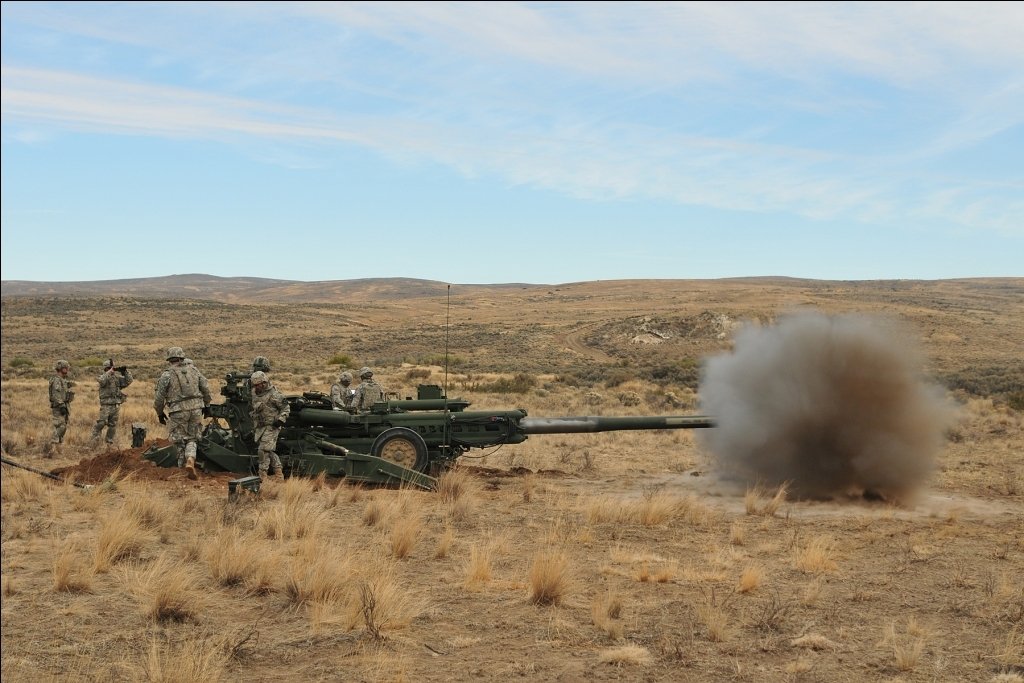14 March 2022
Point-blank range is a distance so close to the target that one can aim an artillery piece directly at its target without adjusting for the fall of the shot, that is the point, or degree, of elevation or depression is blank or zero. (Gravity causes the shot to start falling in a parabolic arc the moment it exits the barrel of a gun, but at very close, i.e., point-blank, ranges this fall is negligible.) Point-blank is also used metaphorically to mean directly or bluntly.
The English term is all but certain to be a borrowing of the Middle French de pointe en blanc. The French phrase appears in the 1570 Les Mémoires de Martin du Bellay in a passage describing the 1544 Siege of Boulogne. English forces had captured the town, and the French had launched a counterattack to retake it:
Monseigneur le Dauphin à toutes forces vouloit marcher luymesmes, & hazarder sa personne pour y donner ordre, mais il ne fut conseillé de ce faire, attendu que le jour estoit venu, & que la ville à coups de canon qui battoient de poincte en blanc, de hault en bas, empeschoit qu’on ne se pouvoit rallier ensemble
(Monseigneur the Dauphin wanted at all costs to march himself and risk his person to give the order there, but he was not advised to do so, as the day had come, and the city, with cannon shots which fire point blank, from top to bottom, made it impossible to rally together.)
The phrase appears in English the next year in Leonard and Thomas Digges A Geometrical Practise, Named Pantometria;
This conclusion serueth most commodiously for all suche as shall haue committed to their charge any platfourme with ordinaunce, for hereby you may exactly at the firste viewe, tell the distance of any shippe or barke, so that hauing a table of Randons made, mounting your peeces accordingly, no vessel can passe by your platfourme (though it be without poynte blancke) but you may with your ordinaunce at the first bouge hir and neuer bestow vayne shotte.
(This conclusion serves most commodiously for all those who have been placed in charge of any platform with ordnance, for now you may at the first view tell exactly the distance of any ship or bark so that having made a table of ranges and elevations [i.e., randoms] and mounting your pieces accordingly, no vessel can pass by your platform (though it be beyond point blank) but you may with your ordnance at the first [shot] bouge her and never bestow a vain shot.)
Bouge is an obsolete verb meaning to stave in a ship’s hull, causing it to leak.
The OED dates this source to 1599 at the latest, i.e., the date of Leonard Digges’s death, but the book was completed by his son and the title page reads “framed by Leonard Digges Gentleman, lately finished by Thomas Digges, his sonne.” Since it appears that the bulk of the actual writing was by Thomas Digges, the 1571 date of publication is the more reliable one for dating the term
The blank in the phrase point blank has caused some confusion over what it refers to. The French blanc usually means white, but here it means null. It refers to the elevation, which is zero, that is pointing directly at the target. If the target were at greater range, the gun would have to be elevated so the shot would fall onto the target. This explanation is given in Robert Norton’s 1624 Of the Art of Great Artillery:
Wherefore I suppose it were more proper to call that only distance Poynt-blanke, which the Peece conueyeth her Shott in a right or insenceable crooked line; the Axis of her Bore lying leuell with the Horizon, that is, she being neither mounted nor embased to any point, or minute of a point, aboue or vnder the Leuell, that being the only Blanke point, that is without numeration, as being the beginning, both of eleuation and depression.
(Wherefore I suppose it would be more proper to call point-blank only that distance which the piece conveys her shot in a right or imperceptibly crooked line; the axis of her bore lying level with the horizon, that is, she being neither mounted or lowered to any point, or minute of a point, above or under the level, that being the only blank point, that is without numeration, as being the beginning, both of elevation and depression.)
The metaphorical use of point blank to mean direct or straightforward appears by the same year. From Robert Burton’s 1624 The Anatomy of Melancholy:
He respects matter, thou art wholly for words, hee loues a loose & free stile, thou art all for neat composition, strong lines, that which one admires, another explodes as most absurd and ridiculous. If it be not point blanke to his humor, his method, his conceipt.
(He respects matter; you are wholly for words. He loves a loose and free style; you are all for neat composition. Strong lines, which one admires, another explodes as most absurd and ridiculous if it is not point blank to his humor, his method, his conceit.)
Sources:
du Bellay, Martin. Les Mémoires de Mess. Martin du Bellay, Signeur de Langey, vol. 2. Paris: Pierre l’Huillier, 1570, 272. ProQuest Early European Books.
Burton, Robert. The Anatomy of Melancholy, second edition. Oxford: John Lichfield and James Short for Henry Cripps, 1624, 8. Early English Books Online (EEBO).
Digges, Leonard and Thomas Digges. A Geometrical Practise, Named Pantometria. London: Henrie Bynneman, 1571, sig. H.5r. Early English Books Online (EEBO).
Norton, Robert. Of the Art of Great Artillery. London: Edward Allde for John Tap, 1624, 3. Early English Books Online (EEBO).
Oxford English Dictionary, third edition, September 2006, s.v. point-blank, n., adv., and adj., point, n.1.
Prins, A.A. “The Etymology of Point-Blank.” English Studies, 29, 1948, 18–21.
Image credit: Kimberly Lessmeister, US Army, 2011. Public domain image.

